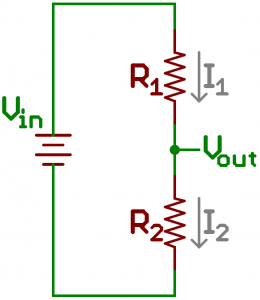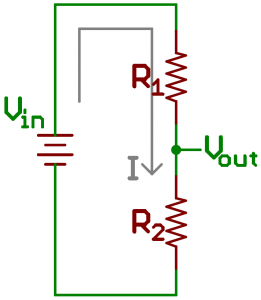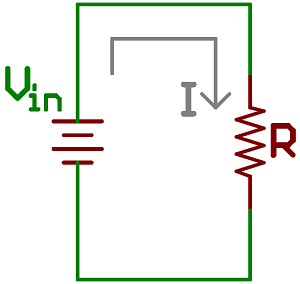Voltage Dividers
Extra Credit: Proof
If you haven't yet gotten your fill of voltage dividers, in this section we'll evaluate how Ohm's law is applied to produce the voltage divider equation. This is a fun exercise, but not super-important to understanding what voltage dividers do. If you're interested, prepare for some fun times with Ohm's law and algebra.
Evaluating the circuit
So, what if you wanted to measure the voltage at Vout? How could Ohm's law be applied to create a formula to calculate the voltage there? Let's assume that we know the values of Vin, R1, and R2, so let's get our Vout equation in terms of those values.
Let's start by drawing out the currents in the circuit--I1 and I2--which we'll call the currents across the respective resistors.
Our goal is to calculate Vout, what if we applied Ohm's law to that voltage? Easy enough, there's just one resistor and one current involved:
Sweet! We know R2's value, but what about I2? That's an unknown value, but we do know a little something about it. We can assume (and this turns out to be a big assumption) that I1 is equivalent to I2. Alright, but does that help us? Hold that thought. Our circuit now looks like this, where I equals both I1 and I2.
What do we know about Vin? Well, Vin is the voltage across both resistors R1 and R2. Those resistors are in series. Series resistors add up to one value, so we could say:
And, for a moment, we can simplify the circuit to:
Ohm's law at its most basic! Vin = I * R. Which, if we turn that R back into R1 + R2, can also be written as:
And since I is equivalent to I2, plug that into our Vout equation to get:
And that, my friends, is the voltage divider equation! The output voltage is a fraction of the input voltage, and that fraction is R2 divided by the sum of R1 and R2.
Interested in learning more foundational topics?
See our Engineering Essentials page for a full list of cornerstone topics surrounding electrical engineering.







